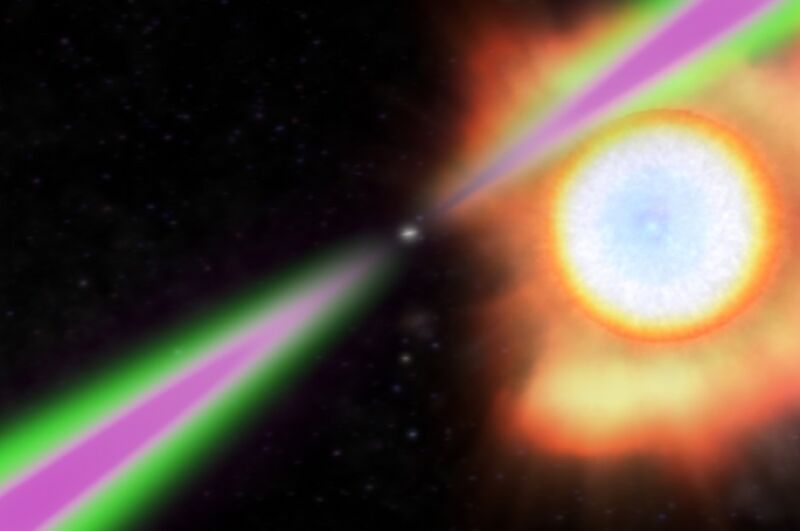
Astronomers have determined the heaviest neutron star known to date, weighing in at 2.35 solar masses, according to a recent paper published in the Astrophysical Journal Letters. How did it get so large? Most likely by devouring a companion star—the celestial equivalent of a black widow spider devouring its mate. The work helps establish an upper limit on just how large neutron stars can become, with implications for our understanding of the quantum state of the matter at their cores.
Neutron stars are the remnants of supernovae. As Ars Science Editor John Timmer wrote last month:
The matter that forms neutron stars starts out as ionized atoms near the core of a massive star. Once the star's fusion reactions stop producing enough energy to counteract the draw of gravity, this matter contracts, experiencing ever-greater pressures. The crushing force is enough to eliminate the borders between atomic nuclei, creating a giant soup of protons and neutrons. Eventually, even the electrons in the region get forced into many of the protons, converting them to neutrons.
This finally provides a force to push back against the crushing power of gravity. Quantum mechanics prevent neutrons from occupying the same energy state in close proximity, and this prevents the neutrons from getting any closer and so blocks the collapse into a black hole. But it's possible that there's an intermediate state between a blob of neutrons and a black hole, one where the boundaries between neutrons start to break down, resulting in odd combinations of their constituent quarks.
Short of black holes, the cores of neutron stars are the densest known objects in the Universe, and because they are hidden behind an event horizon, they are difficult to study. "We know roughly how matter behaves at nuclear densities, like in the nucleus of a uranium atom," said Alex Filippenko, an astronomer at the University of California, Berkeley and co-author of the new paper. "A neutron star is like one giant nucleus, but when you have 1.5 solar masses of this stuff, which is about 500,000 Earth masses of nuclei all clinging together, it's not at all clear how they will behave."
The neutron star featured in this latest paper is a pulsar, PSR J0952-0607—or J0952 for short—located in the constellation Sextans between 3,200 and 5,700 light-years away from Earth. Neutron stars are born spinning, and the rotating magnetic field emits beams of light in the form of radio waves, X-rays, or gamma rays. Astronomers can spot pulsars when their beams sweep across Earth. J0952 was discovered in 2017 thanks to the Low-Frequency Array (LOFAR) radio telescope, following up on data on mysterious gamma ray sources collected by NASA's Fermi Gamma-ray Space Telescope.
Your average pulsar spins at roughly one rotation per second, or 60 per minute. But J0952 is spinning at a whopping 42,000 revolutions per minute, making it the second-fastest-known pulsar thus far. The current favored hypothesis is that these kinds of pulsars were once part of binary systems, gradually stripping down their companion stars until the latter evaporated away. That's why such stars are known as black widow pulsars—what Filippenko calls a "case of cosmic ingratitude":
The evolutionary pathway is absolutely fascinating. Double exclamation point. As the companion star evolves and starts becoming a red giant, material spills over to the neutron star, and that spins up the neutron star. By spinning up, it now becomes incredibly energized, and a wind of particles starts coming out from the neutron star. That wind then hits the donor star and starts stripping material off, and over time, the donor star’s mass decreases to that of a planet, and if even more time passes, it disappears altogether. So, that's how lone millisecond pulsars could be formed. They weren't all alone to begin with—they had to be in a binary pair—but they gradually evaporated away their companions, and now they're solitary.
This process would explain how J0952 became so heavy. And such systems are a boon to scientists like Filippenko and his colleagues keen to weigh neutron stars precisely. The trick is to find neutron star binary systems in which the companion star is small but not too small to detect. Of the dozen or so black widow pulsars the team has studied over the years, only six met that criteria.

J0952's companion star is 20 times the mass of Jupiter and tidally locked in orbit with the pulsar. The side facing J0952 is thus quite hot, reaching temperatures of 6,200 Kelvin (10,700° F), making it bright enough to be spotted with a large telescope.
Fillipenko et al. spent the last four years making six observations of J0952 with the 10-meter Keck telescope in Hawaii to catch the companion star at specific points in its 6.4-hour orbit around the pulsar. They then compared the resulting spectra to the spectra of similar Sun-like stars to determine the orbital velocity. This, in turn, allowed them to calculate the mass of the pulsar.
Finding even more such systems would help place further constraints on the upper limit to how large neutron stars can become before collapsing into black holes, as well as winnowing down competing theories on the nature of the quark soup at their cores. "We can keep looking for black widows and similar neutron stars that skate even closer to the black hole brink," Filippenko said. "But if we don't find any, it tightens the argument that 2.3 solar masses is the true limit, beyond which they become black holes."
DOI: Astrophysical Journal Letters, 2022. 10.3847/2041-8213/ac8007 (About DOIs).
reader comments
63